
A computer mouse is a hand-held pointing device that detects two-dimensional motion relative to a surface. This motion is typically translated into the motion of the pointer on a display, which allows a smooth control of the graphical user interface of a computer.

A pointing device is a human interface device that allows a user to input spatial data to a computer. CAD systems and graphical user interfaces (GUI) allow the user to control and provide data to the computer using physical gestures by moving a hand-held mouse or similar device across the surface of the physical desktop and activating switches on the mouse. Movements of the pointing device are echoed on the screen by movements of the pointer and other visual changes. Common gestures are point and click and drag and drop.
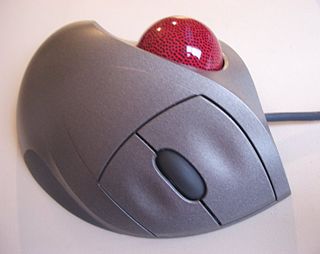
A trackball is a pointing device consisting of a ball held by a socket containing sensors to detect a rotation of the ball about two axes—like an upside-down ball mouse with an exposed protruding ball. Users roll the ball to position the on-screen pointer, using their thumb, fingers, or the palm of the hand, while using the fingertips to press the buttons.

An optical mouse is a computer mouse which uses a light source, typically a light-emitting diode (LED), and a light detector, such as an array of photodiodes, to detect movement relative to a surface. Variations of the optical mouse have largely replaced the older mechanical mouse design, which uses moving parts to sense motion.

A touchpad or trackpad is a type of pointing device. Its largest component is a tactile sensor: an electronic device with a flat surface, that detects the motion and position of a user's fingers, and translates them to a position on a screen, to control a pointer in a graphical user interface. Touchpads are common on laptop computers, contrasted with desktop computers, where mice are more prevalent. Trackpads are sometimes used on desktops, where desk space is scarce. Because trackpads can be made small, they can be found on personal digital assistants (PDAs) and some portable media players. Wireless touchpads are also available, as detached accessories.

Logitech International S.A. is a Swiss company and a multinational manufacturer of computer peripherals and software, with global headquarter in Lausanne, Switzerland. The company has offices throughout Europe, Asia, Oceania, and the Americas, and is one of the world's leading manufacturers of input and interface devices for personal computers (PCs) and other digital products. It is a component of the flagship Swiss Market Index.
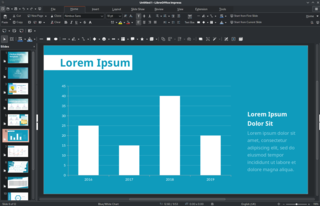
In computing, a presentation program is a software package used to display information in the form of a slide show. It has three major functions:
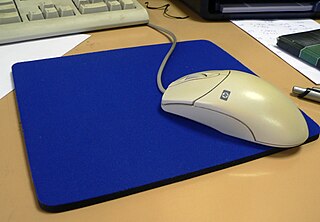
A mousepad or mousemat is a surface for placing and moving a computer mouse. A mousepad enhances the usability of the mouse compared to using a mouse directly on a table by providing a surface to allow it to measure movement accurately and without jitter. Some mousepads increase ergonomics by providing a padded wrist rest.
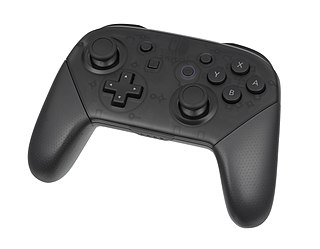
A gamepad is a type of video game controller held in two hands, where the fingers are used to provide input. They are typically the main input device for video game consoles.

A handheld projector is an image projector in a handheld device. It was developed as a computer display device for compact portable devices such as mobile phones, personal digital assistants, and digital cameras, which have sufficient storage capacity to handle presentation materials but are too small to accommodate a display screen that an audience can see easily. Handheld projectors involve miniaturized hardware, and software that can project digital images onto a nearby viewing surface.

A scroll wheel is a wheel used for scrolling. The term usually refers to such wheels found on computer mice. It is often made of hard plastic with a rubbery surface, centred around an internal rotary encoder. It is usually located between the left and right mouse buttons and is positioned perpendicular to the mouse surface. Sometimes the wheel can be pressed left and right, which is actually just two additional macros buttons.
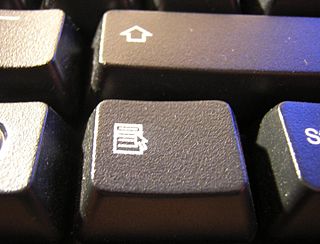
In computing, the menu key or application key is a key found on Microsoft Windows-oriented computer keyboards, introduced at the same time as the Windows logo key. Its symbol is usually a small icon depicting a pointer hovering above a menu, and it is typically found on the right side of the keyboard between the right Windows logo key and the right control key. While the Windows key is present on the vast majority of keyboards intended for use with the Windows operating system, the menu key is frequently omitted in the interest of space, particularly on portable and laptop keyboards.

An interactive whiteboard (IWB), also known as interactive board or smart board, is a large interactive display board in the form factor of a whiteboard. It can either be a standalone touchscreen computer used independently to perform tasks and operations, or a connectable apparatus used as a touchpad to control computers from a projector. They are used in a variety of settings, including classrooms at all levels of education, in corporate board rooms and work groups, in training rooms for professional sports coaching, in broadcasting studios, and others.
In human–computer interaction, a cursor is an indicator used to show the current position on a computer monitor or other display device that will respond to input.
Various accessories for the PlayStation 3 video game console have been produced by Sony and third-party companies. These include controllers, audio and video input devices like microphones, video cameras, and cables for better sound and picture quality.
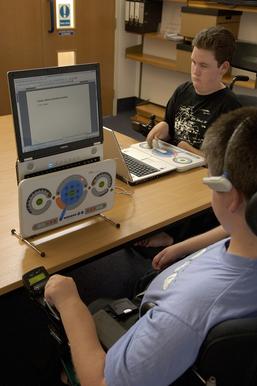
LOMAK is an acronym for Light Operated Mouse And Keyboard. It is an assistive technology device designed for use by people who cannot use a standard computer keyboard and mouse. The Lomak is clipped to an adjustable stand placed vertically underneath the computer screen and is operated by a small laser pointer mounted on a hat or headband. Some people who have arm movement can alternatively use the Lomak horizontally with a hand-pointer. It can be used as an additional keyboard and mouse with any desktop or laptop computer which has a spare USB port. Like many computer peripherals for people with special access needs, it is very expensive, about $1500.
Hillcrest Labs was a sensor processing technology company that developed free space motion-control technology and the first motion-controlled remote for television. Hillcrest also invented the first graphical zoomable interface for television and Kylo, the first Web browser optimized for television. The company, based in Rockville, Maryland, was acquired by CEVA in July 2019.
Various accessories for the PlayStation 2 video game console have been produced by Sony, as well as third parties. These include controllers, audio and video input devices like microphones and video cameras, and cables for better sound and picture quality.

Logitech Harmony is a line of remote controls and home automation products produced by Logitech. The line includes universal remote products designed for controlling the components of home theater systems and other devices that can be controlled via infrared, as well as newer smart home hub products that can be used to additionally control supported Internet of things (IoT) and Smart home products, and allow the use of mobile apps to control devices. On April 10, 2021, Logitech announced that they would discontinue Harmony Remote manufacturing.


















